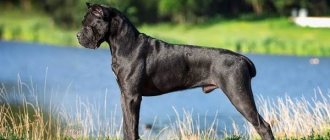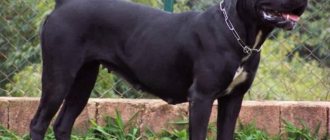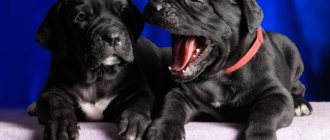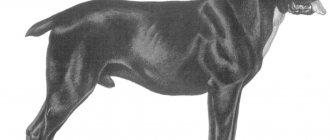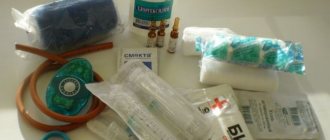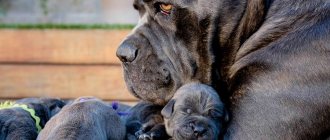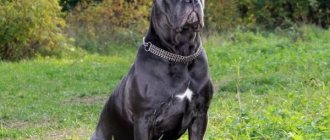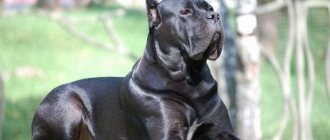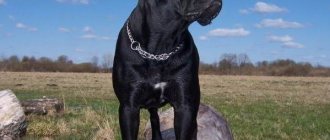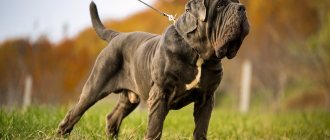When a Cane Corso appears in the house, training and raising the dog plays an important role.
This dog breed dates back to Ancient Rome, and at the genetic level it has a tendency towards guarding and protective functions.
The Cane Corso belongs to the category of large, strong dogs with developed muscles and increased physical activity.
With proper upbringing, she will become a reliable protector for the whole family.
The need for training
Cane Corso are by nature intelligent, good-natured dogs that are great with children. However, like people, animals need gradual development of abilities, i.e. in education and training.
Unlike humans, their behavior is based on instincts.
In the process of evolution of the Cane Corso breed, it received a lot of positive reflexes , which gradually transferred to the genetic level .
In order for them to become the norm of dog behavior, they must be developed as much as possible, suppressing negative and unwanted manifestations.
For a dog, training is training, i.e. development of the necessary instincts.
Constant education and proper training should become an integral part of a pet's life . Only in this case can you raise an intelligent and well-mannered dog.
The Cane Corso is a large dog, and its appearance can frighten people, and incorrect behavior causes panic. Obedience, calmness and a sense of proportion are especially important for this breed.
It is necessary to develop a reserved attitude towards other animals.
Description of the breed standard
The breed description says:
- height: males 64 - 68 cm; females 60-64 cm;
- weight: males 45 - 50 kg; females 40-45 kg;
- color: black, brown of different shades, brindle, gray brindle, red. For light-colored dogs, a dark mask is allowed. Light small spots may be on the chest and ends of the paws.
Cane Corso is an intellectual among canines
For your information! The dog's physique is strong, its muscles are well developed, the dog is lean and strong. The character is balanced and aristocratic by standard.
Secrets of education
By nature, Cane Corso dogs are highly trainable. Taking into account the psychology of the animal and its individual characteristics, Cane Corsos are happy to follow commands and are prone to obedience.
That is why training can be carried out by the owner himself, if he has sufficient patience and willpower.
At what age should training begin? Raising a dog must be carried out from the first day the puppy appears in the house. The ideal time to start training is 3 months of age, but even before that the pet should be accustomed to the collar and respond to its name. It is advisable to toilet train. Serious professional training is most effective when the dog reaches 3 years of age.
CAREFULLY!
If for some reason the initial stage of education is overdue, then you should not despair.
In principle, the Cane Corso can be trained at any age. You just need to take into account that the older the dog is, the more difficult and longer the training course takes.
Where does education and training begin?
First of all, the following issues need to be resolved:
- Prepare and accustom the dog to a training choke collar with a leash. It is composed of ringed metal links. The size of the collar should exceed the head circumference by 25-30 mm. The leash is made of leather and has a width of 20-25 mm and a length of 2 m. The training collar allows you to control the behavior of your pet, because tugging on the leash causes the loop to tighten, and the dog immediately feels the owner’s reaction.
- A stimulating treat. The first lessons should be based on encouraging the right actions, and a tasty treat is a great incentive. The owner must choose what his pet loves most.
- Choosing a place to study. It should be absolutely safe for the puppy when running and jumping. No one and nothing should distract him from his studies. It is best to choose a place that the dog has already explored. In a new place, unknown smells will constantly distract her. Sniffing will take a long time.
- Providing psychological contact. During training, the owner must remain alone with the pet. Any right actions must be accompanied by affection and kind words.
When conducting training, you need to choose the right voice intonation.
Orders are given in a calm but stern voice. A prohibition requires a demanding, threatening intonation. All encouraging and approving messages are made in a cheerful, gentle voice.
Voice commands are accompanied by gestures, and both must be clear and confident.
The optimal conditions for conducting classes are considered to be an air temperature of about 13-17 degrees in the absence of precipitation and strong wind.
It is better to conduct training in the morning and evening before feeding the dog. You cannot train a sick pet, a nursing dog, or a female dog in heat.
During training, the dog must be given rest . It is recommended to alternate exercises with game elements and free movement.
Character Traits of the Cane Corso
The appearance of the dog can frighten those not familiar with this breed and inspire the idea that these are rather fighting dogs that need a firm hand.
However, the description of the Cane Corso breed, especially their character traits, suggests the opposite. It doesn’t matter which family the puppy ends up in: whether he lives with a single person, in a small or large and noisy family, the Corso will fit perfectly into any of them. These are very calm and balanced dogs that know how to adapt to their owner.
Italian Cane Corsos are not created for passively lying on the couch - the breed needs activity. But if the owner cannot take the dog for a walk several times, he will accept his rhythm of life. But it will delight the owner with its sweet appearance.
And yet the Corso was not created as a decorative lap dog. Cane Corsos are very active, and therefore they need long walks with fun games, runs for a stick, and communication with other dogs. Corsos can remain puppies for a very long time, not only in the depths of their souls, but also on its surface.
Even an adult dog, not deprived of attention and fun games in childhood, will happily play with the owner or his child. At the same time, dogs are not at all intrusive, they do not need to constantly talk - they only give voice if there is a reason for it
By the way, Corso dogs make wonderful parents. For example, you can watch a video of a Cane Corso where a dad is playing with his puppies.
By the way, the Corso owner’s children are treated with great care. They will bravely endure all their games, and often even join in all the children's fun. If children are too annoying and pester the dog, it will be more likely to try to hide rather than be aggressive. Well, if the dog is overtaken even in its hiding place, it will endure until the last.
Canes have a highly developed parental instinct, thanks to which they consider everyone who is smaller and weaker to be their children. For this reason, the Corso will carefully protect the owner’s child, although he will never touch other children.
There is also no need to isolate the dog from other pets, because representatives of this breed strive for communication, not dominance, so they can easily get along with cats and other dogs.
The most important thing for a Corso is emotional contact with the owner. They should always feel needed and loved as pets. In fact, dogs are monogamous, that is, they endure a change of family, regardless of the reasons, extremely difficult, as well as isolation, even for educational purposes.
Various ways
Cane Corso training can be done in various ways.:
- Taste-enhancing technique. The method is used often and is based on food motivation. For the correct action, the dog receives a tasty treat. The lesson is recommended to be carried out 4-5 hours after feeding. The disadvantage is that not all skills are taught through treats.
- Mechanical technique. It is based on encouraging stroking or forced influence (jerks with a leash, hand pressure, the influence of a training collar). It is used mainly when training with adult animals.
- Contrast method. It combines elements of the 2 previous methods. A treat is used as a reward, and in case of incorrect behavior, mechanical stimuli are used.
- Game method. The main advantage is the reduction of nervous stress on a young dog. Disadvantage: low efficiency. The technique is considered auxiliary and is usually used in combination with other methods of training.
- Imitative way. It is based on the instinct to imitate the behavior of other dogs. The greatest effect is obtained when training in the presence of the mother, from whom the puppy takes an example. The technique can also be used in collective training. It is recommended to use as an additional method in combination with other methods.
- Push method. Its essence is to force the action to be performed using hands or a leash. It can be used at the initial stage of puppy training and should not cause pain.
The choice of training method depends on the dog’s age, its individual characteristics, and the state of the nervous system. When training on your own, it is better to coordinate it with an experienced dog handler.
Expert opinion
Kozhevin Semyon Kirillovich
Expert dog handler.
“An experienced dog trainer is able to accurately determine the most effective way to train a Cane Corso. In early puppyhood, these dogs are easy to train when using a contrasting technique in combination with play elements. This breed is characterized by increased playfulness, which allows you to captivate the puppy and include educational elements in the game. The dog quickly gets used to commands, and correct actions must be rewarded with treats.”
When is the help of a dog handler needed?
A professional dog handler should be contacted if the pet’s behavior needs to be adjusted, for example, if the dog is too aggressive and the owners cannot cope with it. Also, the help of a trainer may be required if the pet refuses to exercise at home or manipulates the owners.
If during the process of home training a Cane Corso, difficulties arise that the owners cannot deal with, they need to contact a dog trainer.
Getting Some Skills
One of the first skills to teach your Cane Corso puppy is toilet training.
It is too early to accustom a small pet to the outdoor toilet, and therefore he settles down at home.
To do this, you can use a tray with filler, newspapers or a disposable diaper. They should always be located in one place, and the puppy should do “his business” only here.
In order to toilet train your pet, you need to be patient - this process is quite long . First of all, in the apartment where the puppy has settled, it is better to remove carpets and rugs from the floor - they attract the pet and retain the smell for a long time.
When he relieves himself, he is guided by instincts, and therefore he usually chooses a certain place. This is where the toilet should be placed.
It will be much easier to accustom the animal to such a place.
As a rule, such places are located next to the door, under the window, in the corner or on the balcony . It should be provided with free access at any time and not frighten the pet while relieving itself.
If the puppy has chosen an unsuitable place, then it must be weaned from it. To do this, substances are used that repel the dog.
You can use the Antipis tool . A dog will never defecate where food is located. This option can also be used.
We provide proper care
Looking at the huge Italian Mastiff, it is difficult to imagine that he needs any special care. It seems that feeding such an animal enough and giving it space to release its energy is, in fact, all that is needed. Actually this is not true
To keep your pet looking its best and feeling its best, it needs a certain amount of care and attention.
Ears and eyes
Taking care of your eyes means that they should not become sour. If you notice lumps, mucus residue, or dried crusts in the inner corner of the eye, carefully remove them with a clean, soft cloth. The eyelids of a purebred Cane Corso should not be droopy or damp. If the problem recurs, you need to show the animal to a veterinarian.
Periodically, at least once a week (and certainly before the exhibition), look into your pet’s ears. All dirt accumulated there must be cleaned with damp gauze.
Important! If you have cropped your dog's ears, you need to be especially careful when cleaning them, as cropped ears become more dirty.
Pus, mucus or an unpleasant odor from the ears is a reason to show the animal to the doctor.
Grooming
Even though Italian Mastiffs are smooth-haired, they still need to be brushed occasionally. It is advisable to carry out the procedure once a week, using a stiff brush. The fact is that these dogs shed a lot, so brushing will remove falling hair and at the same time get rid of dead particles of the epidermis.
A furminator will help get rid of dog hair.
The Cane Corso has almost completely no undercoat.
Nail trimming
Trimming the nails of a large dog is not a very easy procedure, but if the nails do not grind down when walking, sometimes it still needs to be done, otherwise the animal begins to experience discomfort. If you hear the characteristic clicking sound that accompanies your pet’s walking on the parquet, it means it’s time for a pedicure.
There are two options: periodically contact a veterinary clinic or, for example, a dog groomer for this task, or get the necessary tools (the pliers must match the size of your four-legged friend’s claws) and learn how to do it yourself
There is nothing complicated in such an “operation”, the only important thing is not to catch the blood vessel located in the upper part of the claw. Ask a specialist to show you a master class, and in the future you will be able to cope with this simple task yourself.
Dental care
Fortunately, brushing your Cane Corso's teeth may not be necessary if you feed your dog dry food and follow all the instructions regarding vitamins and other supplements. Fortunately, because getting into the mouth of such a thug is still not the most exciting activity. However, if your pet is fed natural food, you will still have to periodically look into its mouth with a toothbrush.
To minimize the frequency of such procedures, it is recommended to regularly pamper your pet with a variety of “chews”, which are available in abundance in specialized pet stores. This is an excellent prevention of the formation of stones on teeth.
Bathing
Most dogs enjoy swimming, keeping their owner company on the seashore or by the river. But bathing as such, as a hygienic procedure, is not at all beneficial for their skin. Therefore, if your dog is not covered in mud or if you are not preparing for a serious exhibition, there is no need to bathe him. It is enough to wash dirty paws and comb out the fur.
Walking the dog
Unlike many other large breeds, Cane Corsos are very active and athletic. If necessary, this dog can sit for a long time and motionless at your feet, but this does not mean that he does not need to move. Especially at a young age, the dog must be given the opportunity every day to run, jump and frolic in the open air, including with other dogs.
When the dog gets older, it can be content with daily (preferably long) walks on a leash, but at least sometimes the dog needs to run around to its heart's content.
Important! If the dog has not undergone special training, it may be a problem for the owner to keep it if it decides to hunt a cat carelessly caught on the road. However, the cat may have even more problems!
These points must be taken into account by novice dog breeders, as well as careless parents who frivolously send small children to “walk the dog”
These points must be taken into account by novice dog breeders, as well as careless parents who frivolously send small children to “walk the dog.”
Team "Place"
The next important step in raising a puppy is the execution of the “Place” command.
This command carries two meanings . At home, this is how the dog is instructed to go to its bedding and not disturb people. The pet usually quickly understands what they want from him and leaves with resentment for a while. Then he leaves the litter, but no longer gets bored.
IMPORTANT!
On the street the meaning of the command is different. The “place” becomes the object or area to which the owner points.
This command is taught in this way. At home, you can use a taste-enhancing method.
After giving the “Place” command, you should lure the puppy onto its bedding and reward it with a treat. After repeated repetition, this action will become a reflex.
On the street, it is worth thinking about the special skills of the dog - guard . To do this, place a bag or backpack in a certain place that is well known to the animal.
Naturally, the dog’s guard instinct is triggered, and it lies down or sits next to him. Then the owner moves a few meters to the side and calls her to him.
After that, he points to the thing and orders the dog “Place”, and it comes back . After some time, things no longer lie down, but simply pointing to an object is enough. The correct action of the pet should be rewarded.
Choosing a puppy
Purebred Cane Corso puppies are very expensive, and it cannot be otherwise, because compliance with all the formalities necessary to ensure “purity of blood” (exhibitions, examinations, etc.) is not a cheap pleasure. But dogs still need to be provided with normal maintenance, adequate nutrition, and vaccination.
Unfortunately, high prices for animals always attract people who seek to reduce their expenses in every possible way. Compliance with the breed with all its inherent characteristics is the last thing that interests such businessmen
That is why, when choosing a puppy, you should exercise maximum attention and caution.
Important! A pedigree for an animal is not just a “certificate of honor” confirming your status. This is a guarantee that your pet fully complies with the declared characteristics, and these are not only external signs, but also character traits
For example, as already mentioned, a Cane Corso cannot be cowardly or aggressive; the systematic disqualification of such dogs and their exclusion from breeding work provides an appropriate guarantee. However, when buying a puppy without a pedigree, you are purchasing a “pig in a poke.” And if such a “cat” weighs under 70 kg, think for yourself what awaits you.
On the other hand, a pedigree is just paper that can be forged. It is especially easy to fall for the bait if you have never been involved in dog breeding before and do not know the basic rules. Therefore, before purchasing, it is imperative to make detailed inquiries about the history of the nursery, carefully study the documents of the parents, show them to specialists and make sure that the mating is officially registered.
When making an agreement with the breeder in advance, talk to him. Ask for a photo of the puppies and parents, making sure it is genuine and not taken from an unrelated Cane Corso website. Listen to what the seller tells you about the breed, compare the information received with the corresponding descriptions on the Internet. As a rule, at this stage you can already understand whether you are dealing with a true enthusiast (and you can only purchase animals from such people) or a selfish entrepreneur who wants to get rid of the goods as quickly as possible.
By the way, self-respecting breeders always stipulate the possibility of returning the animal if for one reason or another it is not suitable for you (for example, someone in the household suddenly discovers an allergy to dog hair). Ask this question and see the reaction. Of course, making a promise does not mean getting married, but if they immediately tell you something like “the map is the place!”, think about buying a puppy from more conscientious and responsible people.
Don't buy a puppy on neutral territory. Take your time, ask to visit the breeder, look at the parents and the conditions in which the dogs are kept. Their appearance and mood will speak for themselves.
Buying any purebred animal, and especially a large breed dog, from unknown people at the poultry market is absolutely prohibited! This is irresponsible and sometimes physically unsafe (remember the joke about the man wandering around the market with a bear and unsuccessfully trying to find the person from whom he bought a Chihuahua puppy six months ago).
And, of course, the price. For a good breeder, breeding dogs is not so much a source of income as it is pleasure. As already mentioned, high prices for purebred animals are determined objectively, and not as a result of a “cartel agreement” between dog breeders. The price of real Cane Corso puppies usually starts from a thousand US dollars and, depending on the class of the parents and the baby itself, can increase significantly.
On the other hand, if there are minor defects (which you should definitely be warned about), you can buy a good animal and a little cheaper. If you are not going to engage in breeding and are ready to sterilize your dog, this option is quite acceptable. But in any case, you must understand the nature of price formation. And if a friend (or stranger) offers you to buy an excellent puppy for a hundred bucks, it’s better to take an animal from a shelter, at least you’ll do a good deed.
Features of executing various commands
When training a puppy, it is important to teach a few basic commands.:
- "To me" . This is a basic command that a puppy learns to use immediately after learning its name. To present it, the dog’s name is clearly stated, and then pronounced in a demanding tone, “Come to me.” At the beginning of training, you should show your pet a treat, which will make him want to follow the command.
- "Ugh" . The command prohibits lifting anything. When teaching, a mechanical method is used. Food is placed on the ground (floor), but when the dog tries to pick it up, a command is pronounced and a prohibiting action is carried out - a tug on the leash, tightening the collar loop, a light slap on the face with a newspaper or a fly swatter on the head. The action must indicate the existence of danger posed by the object.
- "Near" . With this command, the puppy must stand close to the owner on the left. When training the puppy, the correct execution of the command is indicated with the help of a leash, and after its execution, he is rewarded with a treat.
- "Sit" . This command is duplicated by raising the palm to chest level, while the arm is moved to the left side. When training with your fingers, the dog's pelvic area (lower back) is pressed. With such pressure, the animal’s instinct is triggered, and it sits down. Don't forget about encouragement.
- "Lie" . For a guard dog, this command is important. In order for the puppy to comply with the command, you need to press with your hand in the area between the shoulder blades. After execution - an incentive.
- "Exposure" or "Wait" . The command can be performed while standing, lying down or sitting. In the first case, the dog must remain in a given position for at least 10-15 seconds, and in the second - up to 0.5 hours. Compliance is achieved by rewarding with a treat. At first, the owner does not leave the dog’s visibility, but gradually disappears as the interval of absence lengthens.
- "Give" . Initial exercises are carried out with a puppy toy. After pronouncing the command, the toy is taken from the puppy’s mouth, and his attention is diverted to another object. Action is encouraged. Skills are reinforced with food (a bowl of food, a bone). If the puppy shows aggression, it is recommended to apply pressure with your hand in the area between the shoulder blades, forcing him to lie down. With such training, it is important that the dog understands who is “boss” in the house. She must give away any item.
- "Aport" . Classes to master this command are held outside the home. During the first “lessons,” a favorite dog toy is used. She rushes, then the puppy runs and grabs her. Next the command “Come to me” sounds, and after its execution - “Give”. In subsequent classes, you can use any other items. Usually dogs engage in such training with pleasure, because... it's very game-like.
- "Face" . This team should be the final one in training. It is only permissible for an obedient dog, because... can teach unexpected aggression. For training, an assistant with protective clothing is required. Training is carried out when the dog reaches one year of age.
The listed commands can be attributed to the basic set. Training is carried out alternately.
Some of them are impossible without mastering other skills.
In general, the duration of training for puppies should not exceed 45-60 minutes with rest breaks.
General principles of animal training
To successfully train a pet, systematic training is necessary. The duration of the lesson should not exceed 2 hours. Commands for dogs: the list of techniques practiced in the lesson depends on the level of training of the animal; for example, a Labrador puppy begins to be trained from the first months. Gradually the number of teams should be increased.
New techniques are practiced in the first part of the lesson. After each command, a three-minute break is required for the pet.
Rules for successfully training a puppy:
- Techniques performed correctly should be reinforced with praise and encouragement.
- It is better to voice the instruction once, accompanied by a gesture.
- Maintaining consistency in orders and gestures.
- The first classes are conducted in a familiar environment, then change the environment.
- The trainer and the dog are in a good mood.
- It is better to end the lesson with an instruction that the puppy does better than others.
Training an adult dog
When the puppy age for training is missed, it can be done with adult dogs, but this will require special patience. The animal has already developed certain reflexes, and its psychology must be taken into account during training.
NOTE!
The most important thing is to teach your dog to behave correctly outside.
To do this, first of all, you will need commands such as “Nearby”, “Exposure”, “Wait”, “Sit”. In principle, the training is not much different from training puppies, but in the incentive part you should not get carried away with treats.
For an adult dog, vocal and mechanical, caressing encouragement is very important.
You can’t scold her, but praise will give the desired result.
You should talk to your dog more.
A serious problem arises when an adult dog displays unprovoked aggression towards people or animals on the street. First of all, we need to find out the reasons for this behavior.
Very often her instinct to protect her territory is triggered (shown in the photo) . In this case, it is necessary to remove as much as possible objects that may become the object of protection.
You may need to change your walking location to prevent your dog from becoming accustomed to one area.
Step-by-step training
When training a Cane Corso, it is important to take into account the age characteristics of the dog.
We can distinguish the following main stages of education and training::
- Up to 3 months. It is considered optimal to purchase a puppy at the age of 2-4 weeks. He does not yet feel fear of novelty and easily adapts to a new environment. Fear appears around the age of 2-2.5 months, and such puppies require special attention. During this period, it is important to create confidence in your pet’s safety. He must master the entire apartment and assimilate all the familiar smells. It is necessary to provide his own place, which cannot be touched by strangers. At this stage, the commands “Place” and “Fu” are taught.
- Age 4-5 months. During this period, vaccination is completed, and the puppy can be taken outside the home. You can start teaching the commands “Come to me”, “Sit”, “Lie down”, “Near”, “Give”. It is useful to start socializing with other dogs. At this stage, it is important to promptly stop emerging aggression, excessive caution and timidity. A reasonable balance of activity and caution must be ensured.
- Age 6-7 months. The dog develops a “pack” instinct. She begins to look for her place in the hierarchy. It is important not to miss the moment, because the role of the “leader” is being decided, and the authority of the owner must remain unquestioned. The learned commands can be replenished - “Fetch”, “Voice”.
- Age 8-12 months. This is a difficult stage of puberty and hormonal surges. The dog develops aggression towards dogs of the same sex. At this stage, sometimes you have to periodically repeat previously learned commands. During this period, fear and phobias develop especially actively, which should not be allowed.
- Up to 4 years of age. This is the dog's maturity stage. It is still possible to carry out training, but it must be done taking into account the current psyche. Starting from the age of one, you can teach the “Face” command. If necessary, professional training is provided as a watchman. At this age, you cannot put too much pressure on the animal’s psyche, humiliate and oppress it. It is strictly not recommended to hit a dog.
Raising and training a pet, in principle, occurs throughout its life.
Periodically it is worth reminding half-forgotten skills and getting rid of unwanted reflexes.
Outdoor training
At three months, the dog leaves the apartment and gets acquainted with the world outside the home. Walks are short, in the yard, so that the baby does not get tired. She goes to the toilet wearing a diaper, but she is praised for relieving herself on the street, encouraging her to learn to relieve herself in the right place. Attention is paid to communication with animals and people. A pet should not approach strangers without permission. It is important that taking treats from people is prohibited, as is lifting them from the ground.
By the age of six months, the puppy has the necessary minimum skills:
- Knows the nickname.
- Capable of following with a person without instructions.
- Returns when called.
- Stops at prohibitory signals.
- Silences on command.
- Reacts to “sit”, “lie down”, “paw”, “fu”.
As the pet grows up, it looks for a leader, and the owner must take his role. If authority is not established, it is worth visiting a dog handler and receiving training from professionals.
